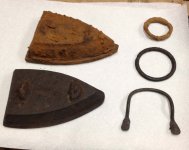TimeWaster
Jr. Member
- Oct 8, 2012
- 83
- 30
- Primary Interest:
- All Treasure Hunting
Man this electrolysis thing is some kind of cool! I figured I would make an electrolysis device for my rusty, otherwise worthless finds. Good things to learn with! After a few hours, the rust came off in sheets like I had applied paint remover! Now the details really stick out, not that these objects had much more details to see! 






